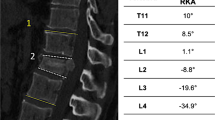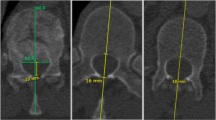Summary
To calculate canal compromise and decrease of midsagittal diameter caused by retropulsion of fragments into the spinal canal we analyzed the pre- and postoperative computed tomographies of 32 patients with unstable thoracolumbar burst fractures treated by USS (universal spine system). Our intention was to examine the efficiency of ultrasound guided repositioning of the dispaced fragments which was performed in all 32 cases. We found a clear postoperative enlargement of canal area (ASP preoperatively 55 %, postop. 80 %) and midsagittal diameter (MSD preop. 58 %, postop. 78 %). 10 of 13 patients presented a postoperative improvement of neurological deficit, no neurological deterioration occured. Fractures with neurological deficit showed more canal compromise (52 %) and less midsagittal diameter (MSD compromise 51 %) than those without (40 % or 39 %). There was no correlation between the percentage of spinal canal stenosis and the severity of neurological deficit. Below L 1 the spinal canal is greater than between Th 11 and L 1, so a more important spinal stenosis is tolerated. In case of unstable burst fractures with neurological deficit the ultrasound guided spinal fracture reposition is an effective procedure concerning the necessary improvement of spinal stenosis: an additional ventral approach for the revision of the spinal canal is unneeded. In fractures without neurologic deficit the repositioning of the displaced fragments promises an avoidance of long-term damages such as myelopathia and claudicatio spinalis.
Zusammenfassung
Anhand der prä- und postoperativen Computertomogramme (CT) von 32 Patienten mit instabilen, durch USS (universal spine system) versorgten, thorakolumbalen Wirbelfrakturen führten wir eine planimetrische Auswertung des Spinalkanals durch. Unser Ziel war es, die Effizienz der unter intraoperativer, sonographischer Kontrolle durchgeführten direkten Reposition stenosierender Hinterkantenfragmente zu überprüfen. Postoperativ resultierte eine deutliche Aufweitung der spinalen Stenosierung sowohl hinsichtlich der Fläche des Spinalkanals (ASP präoperativ 55 %, postoperativ 80 %) als auch in bezug auf den mittsagittalen Durchmesser (MSD präoperativ 58 %, postoperativ 78 %); 10 von 13 Patienten mit neurologischen Ausfallserscheinungen erfuhren postoperativ eine entscheidende Besserung der Symptomatik, eine Verschlechterung trat nicht ein. Bei Frakturen mit neurologischer Begleitsymptomatik war der Spinalkanal stärker eingeengt (Reduktion ASP: 52 %, MSD: 51 %) als in den Fällen ohne neurologische Störungen (Reduktion ASP: 40 %, MSD: 39 %). Eine Korrelation zwischen dem Grad der spinalen Stenose und der Schwere neurologischer Ausfallserscheinungen bestand nicht. Unterhalb von L 1 ist der Spinalkanal weiter als zwischen Th 11 und L 1 und toleriert so eine stärkere Einengung. Bei instabilen Berstungsfrakturen mit neurologischer Symptomatik erweist sich die direkte Reposition stenosierender Hinterkantenfragmente in bezug auf die erforderliche spinale Dekompression als effizientes Verfahren, welches eine Revision des Spinalkanals von ventral überflüssig macht. Bei Frakturen ohne neurologische Ausfallserscheinungen verspricht die Fragmentreposition eine Vermeidung von Spätschäden des Rückenmarks im Sinne der Myelopathie und Claudicatio spinalis.
Similar content being viewed by others
Author information
Authors and Affiliations
Rights and permissions
About this article
Cite this article
Rudig, L., Seidel, T., Düber, C. et al. Die Effizienz der sonographisch kontrollierten direkten Reposition von Fragmenten der Wirbelkörperhinterkante. Unfallchirurg 101, 259–264 (1998). https://doi.org/10.1007/s001130050266
Published:
Issue Date:
DOI: https://doi.org/10.1007/s001130050266




